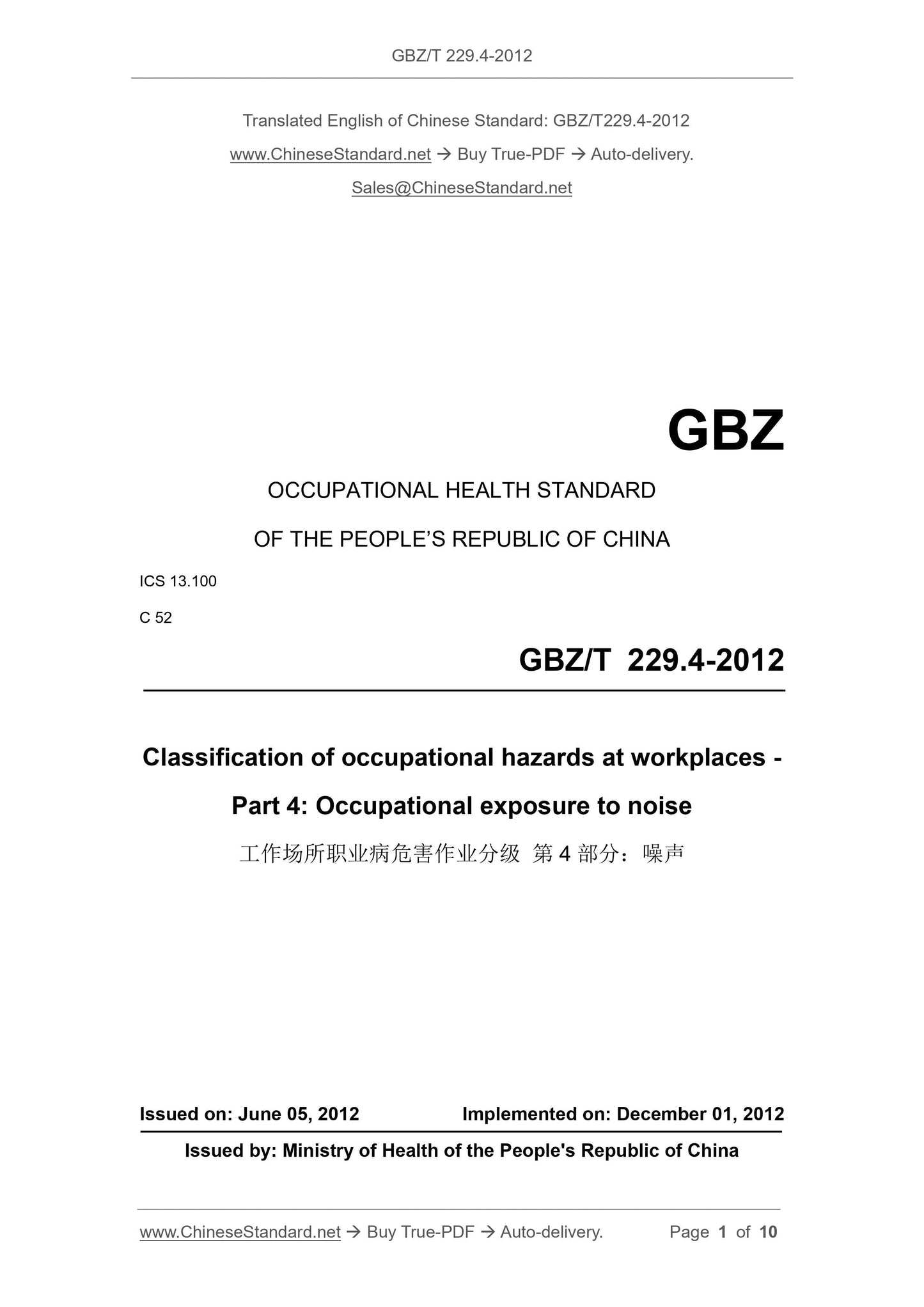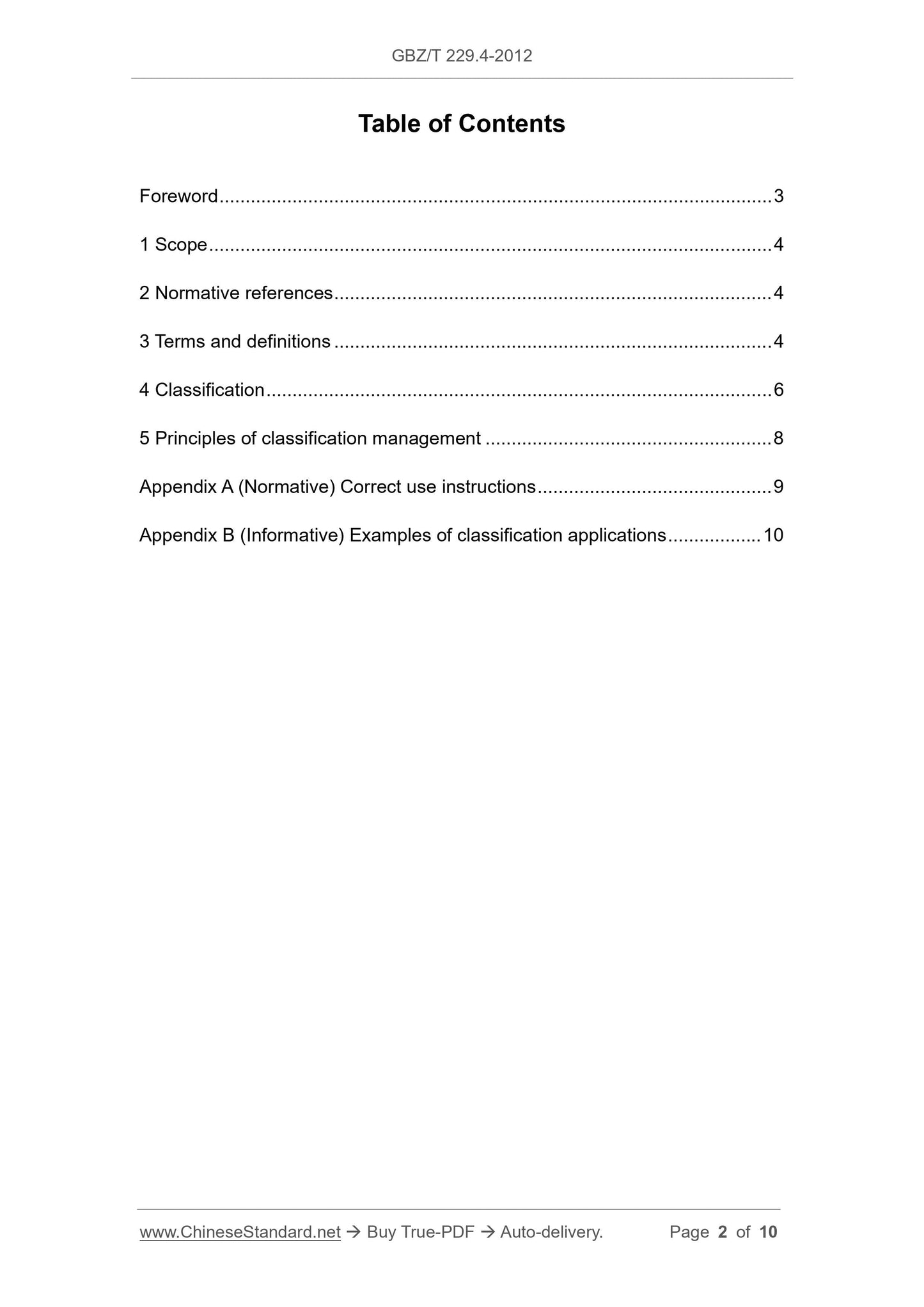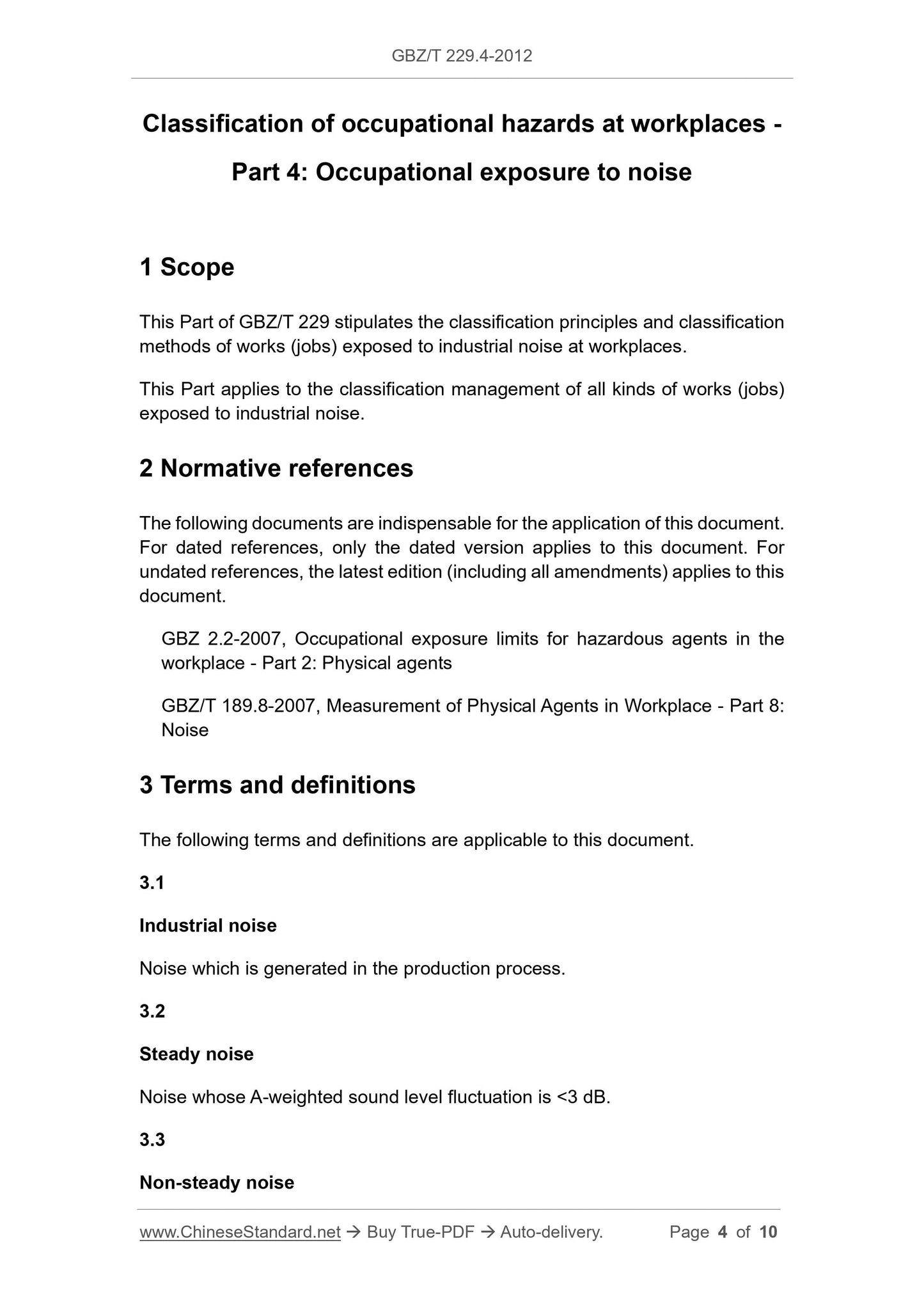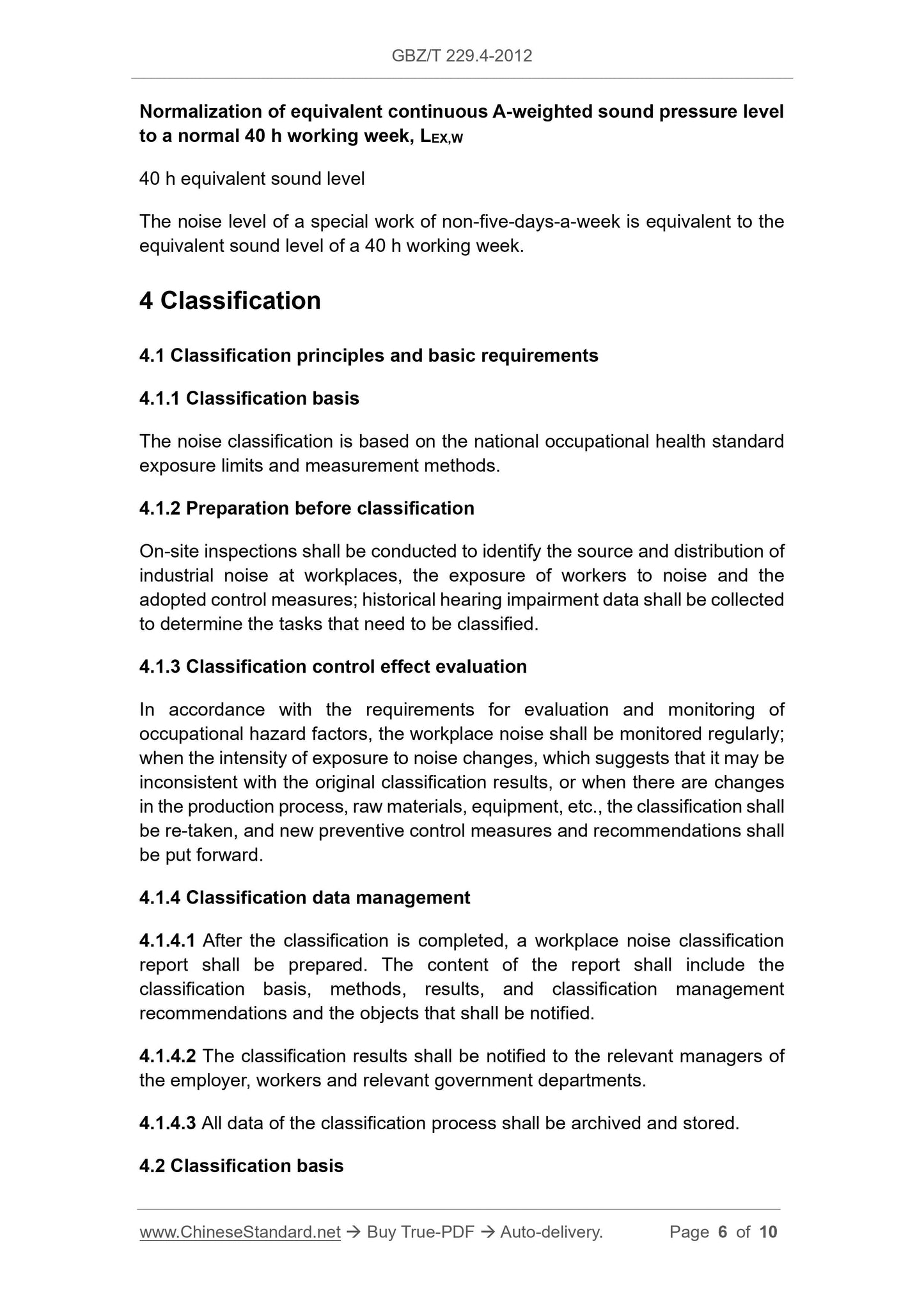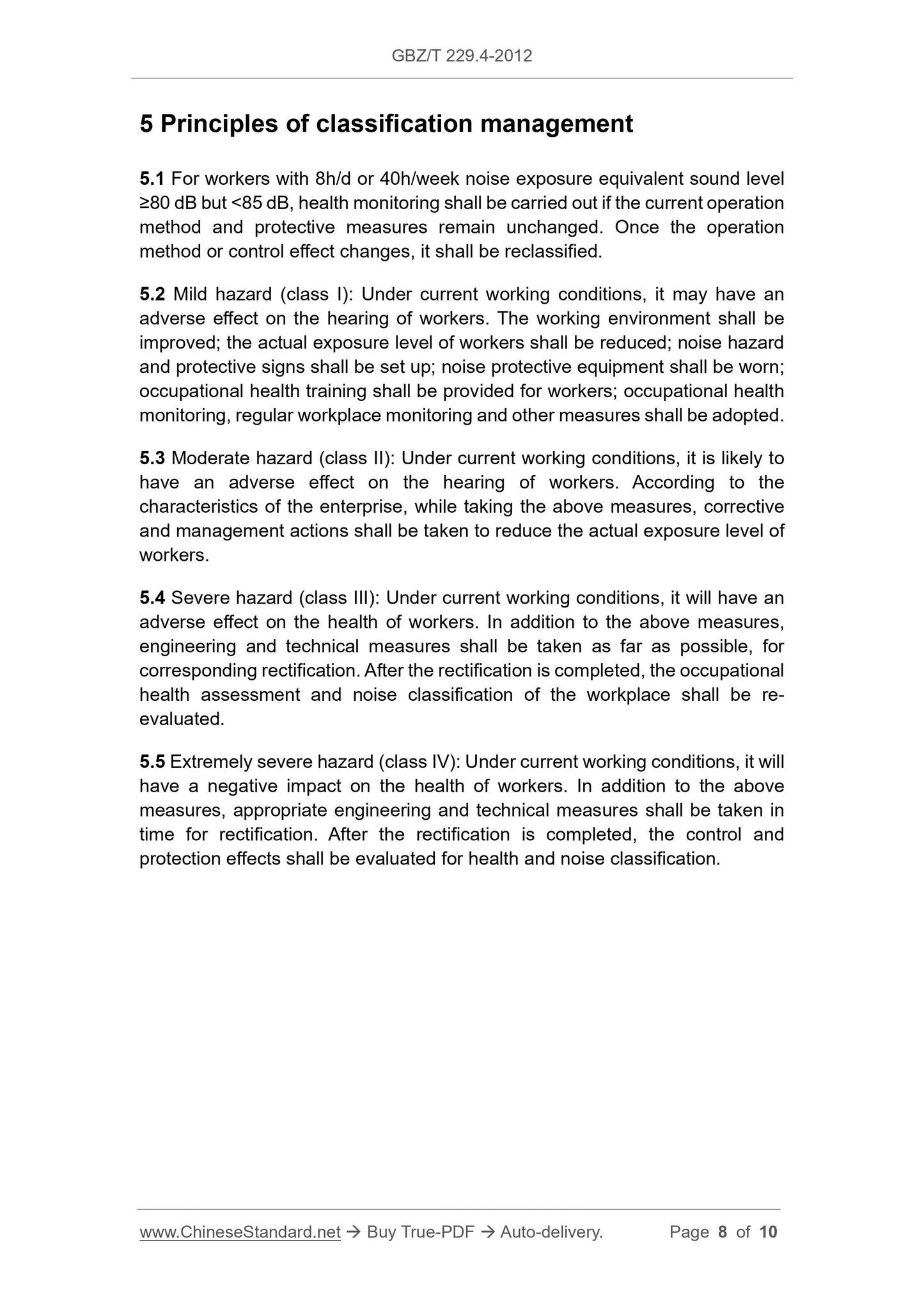1
/
of
5
www.ChineseStandard.us -- Field Test Asia Pte. Ltd.
GBZ/T 229.4-2012 English PDF (GBZ/T229.4-2012)
GBZ/T 229.4-2012 English PDF (GBZ/T229.4-2012)
Regular price
$145.00
Regular price
Sale price
$145.00
Unit price
/
per
Shipping calculated at checkout.
Couldn't load pickup availability
GBZ/T 229.4-2012: Classification of occupational hazards at workplaces - Part 4: Occupational exposure to noise
Delivery: 9 seconds. Download (& Email) true-PDF + Invoice.
Get Quotation: Click GBZ/T 229.4-2012 (Self-service in 1-minute)
Historical versions (Master-website): GBZ/T 229.4-2012
Preview True-PDF (Reload/Scroll-down if blank)
GBZ/T 229.4-2012
GBZ
OCCUPATIONAL HEALTH STANDARD
OF THE PEOPLE’S REPUBLIC OF CHINA
ICS 13.100
C 52
Classification of occupational hazards at workplaces -
Part 4: Occupational exposure to noise
ISSUED ON: JUNE 05, 2012
IMPLEMENTED ON: DECEMBER 01, 2012
Issued by: Ministry of Health of the People's Republic of China
Table of Contents
Foreword ... 3
1 Scope ... 4
2 Normative references ... 4
3 Terms and definitions ... 4
4 Classification ... 6
5 Principles of classification management ... 8
Appendix A (Normative) Correct use instructions ... 9
Appendix B (Informative) Examples of classification applications ... 10
Classification of occupational hazards at workplaces -
Part 4: Occupational exposure to noise
1 Scope
This Part of GBZ/T 229 stipulates the classification principles and classification
methods of works (jobs) exposed to industrial noise at workplaces.
This Part applies to the classification management of all kinds of works (jobs)
exposed to industrial noise.
2 Normative references
The following documents are indispensable for the application of this document.
For dated references, only the dated version applies to this document. For
undated references, the latest edition (including all amendments) applies to this
document.
GBZ 2.2-2007, Occupational exposure limits for hazardous agents in the
workplace - Part 2: Physical agents
GBZ/T 189.8-2007, Measurement of Physical Agents in Workplace - Part 8:
Noise
3 Terms and definitions
The following terms and definitions are applicable to this document.
3.1
Industrial noise
Noise which is generated in the production process.
3.2
Steady noise
Noise whose A-weighted sound level fluctuation is < 3 dB.
3.3
Non-steady noise
Normalization of equivalent continuous A-weighted sound pressure level
to a normal 40 h working week, LEX,W
40 h equivalent sound level
The noise level of a special work of non-five-days-a-week is equivalent to the
equivalent sound level of a 40 h working week.
4 Classification
4.1 Classification principles and basic requirements
4.1.1 Classification basis
The noise classification is based on the national occupational health standard
exposure limits and measurement methods.
4.1.2 Preparation before classification
On-site inspections shall be conducted to identify the source and distribution of
industrial noise at workplaces, the exposure of workers to noise and the
adopted control measures; historical hearing impairment data shall be collected
to determine the tasks that need to be classified.
4.1.3 Classification control effect evaluation
In accordance with the requirements for evaluation and monitoring of
occupational hazard factors, the workplace noise shall be monitored regularly;
when the intensity of exposure to noise changes, which suggests that it may be
inconsistent with the original classification results, or when there are changes
in the production process, raw materials, equipment, etc., the classification shall
be re-taken, and new preventive control measures and recommendations shall
be put forward.
4.1.4 Classification data management
4.1.4.1 After the classification is completed, a workplace noise classification
report shall be prepared. The content of the report shall include the
classification basis, methods, results, and classification management
recommendations and the objects that shall be notified.
4.1.4.2 The classification results shall be notified to the relevant managers of
the employer, workers and relevant government departments.
4.1.4.3 All data of the classification process shall be archived and stored.
4.2 Classification basis
5 Principles of classification management
5.1 For workers with 8h/d or 40h/week noise exposure equivalent sound level
≥80 dB but < 85 dB, health monitoring shall be carried out if the current operation
method and protective measures remain unchanged. Once the operation
method or control effect changes, it shall be reclassified.
5.2 Mild hazard (class I): Under current working conditions, it may have an
adverse effect on the hearing of workers. The working environment shall be
improved; the actual exposure level of workers shall be reduced; noise hazard
and protective signs shall be set up; noise protective equipment shall be worn;
occupational health training shall be provided for workers; occupational health
monitoring, regular workplace monitoring and other measures shall be adopted.
5.3 Moderate hazard (class II): Under current working conditions, it is likely to
have an adverse effect on the hearing of workers. According to the
characteristics of the enterprise, while taking the above measures, corrective
and management actions shall be taken to reduce the actual exposure level of
workers.
5.4 Severe hazard (class III): Under current working conditions, it will have an
adverse effect on the health of workers. In addition to the above measures,
engineering and technical measures shall be taken as far as possible, for
corresponding rectification. After the rectification is completed, the occupational
health assessment and noise classification of the workplace shall be re-
evaluated.
5.5 Extremely severe hazard (class IV): Under current working conditions, it will
have a negative impact on the health of workers. In addition to the above
measures, appropriate engineering and technical measures shall be taken in
time for rectification. After the rectification is completed, the control and
protection effects shall be evaluated for health and noise classification.
GBZ/T 229.4-2012
GBZ
OCCUPATIONAL HEALTH STANDARD
OF THE PEOPLE’S REPUBLIC OF CHINA
ICS 13.100
C 52
Classification of occupational hazards at workplaces -
Part 4: Occupational exposure to noise
ISSUED ON: JUNE 05, 2012
IMPLEMENTED ON: DECEMBER 01, 2012
Issued by: Ministry of Health of the People's Republic of China
Table of Contents
Foreword ... 3
1 Scope ... 4
2 Normative references ... 4
3 Terms and definitions ... 4
4 Classification ... 6
5 Principles of classification management ... 8
Appendix A (Normative) Correct use instructions ... 9
Appendix B (Informative) Examples of classification applications ... 10
Classification of occupational hazards at workplaces -
Part 4: Occupational exposure to noise
1 Scope
This Part of GBZ/T 229 stipulates the classification principles and classification
methods of works (jobs) exposed to industrial noise at workplaces.
This Part applies to the classification management of all kinds of works (jobs)
exposed to industrial noise.
2 Normative references
The following documents are indispensable for the application of this document.
For dated references, only the dated version applies to this document. For
undated references, the latest edition (including all amendments) applies to this
document.
GBZ 2.2-2007, Occupational exposure limits for hazardous agents in the
workplace - Part 2: Physical agents
GBZ/T 189.8-2007, Measurement of Physical Agents in Workplace - Part 8:
Noise
3 Terms and definitions
The following terms and definitions are applicable to this document.
3.1
Industrial noise
Noise which is generated in the production process.
3.2
Steady noise
Noise whose A-weighted sound level fluctuation is < 3 dB.
3.3
Non-steady noise
Normalization of equivalent continuous A-weighted sound pressure level
to a normal 40 h working week, LEX,W
40 h equivalent sound level
The noise level of a special work of non-five-days-a-week is equivalent to the
equivalent sound level of a 40 h working week.
4 Classification
4.1 Classification principles and basic requirements
4.1.1 Classification basis
The noise classification is based on the national occupational health standard
exposure limits and measurement methods.
4.1.2 Preparation before classification
On-site inspections shall be conducted to identify the source and distribution of
industrial noise at workplaces, the exposure of workers to noise and the
adopted control measures; historical hearing impairment data shall be collected
to determine the tasks that need to be classified.
4.1.3 Classification control effect evaluation
In accordance with the requirements for evaluation and monitoring of
occupational hazard factors, the workplace noise shall be monitored regularly;
when the intensity of exposure to noise changes, which suggests that it may be
inconsistent with the original classification results, or when there are changes
in the production process, raw materials, equipment, etc., the classification shall
be re-taken, and new preventive control measures and recommendations shall
be put forward.
4.1.4 Classification data management
4.1.4.1 After the classification is completed, a workplace noise classification
report shall be prepared. The content of the report shall include the
classification basis, methods, results, and classification management
recommendations and the objects that shall be notified.
4.1.4.2 The classification results shall be notified to the relevant managers of
the employer, workers and relevant government departments.
4.1.4.3 All data of the classification process shall be archived and stored.
4.2 Classification basis
5 Principles of classification management
5.1 For workers with 8h/d or 40h/week noise exposure equivalent sound level
≥80 dB but < 85 dB, health monitoring shall be carried out if the current operation
method and protective measures remain unchanged. Once the operation
method or control effect changes, it shall be reclassified.
5.2 Mild hazard (class I): Under current working conditions, it may have an
adverse effect on the hearing of workers. The working environment shall be
improved; the actual exposure level of workers shall be reduced; noise hazard
and protective signs shall be set up; noise protective equipment shall be worn;
occupational health training shall be provided for workers; occupational health
monitoring, regular workplace monitoring and other measures shall be adopted.
5.3 Moderate hazard (class II): Under current working conditions, it is likely to
have an adverse effect on the hearing of workers. According to the
characteristics of the enterprise, while taking the above measures, corrective
and management actions shall be taken to reduce the actual exposure level of
workers.
5.4 Severe hazard (class III): Under current working conditions, it will have an
adverse effect on the health of workers. In addition to the above measures,
engineering and technical measures shall be taken as far as possible, for
corresponding rectification. After the rectification is completed, the occupational
health assessment and noise classification of the workplace shall be re-
evaluated.
5.5 Extremely severe hazard (class IV): Under current working conditions, it will
have a negative impact on the health of workers. In addition to the above
measures, appropriate engineering and technical measures shall be taken in
time for rectification. After the rectification is completed, the control and
protection effects shall be evaluated for health and noise classification.
Delivery: 9 seconds. Download (& Email) true-PDF + Invoice.
Get Quotation: Click GBZ/T 229.4-2012 (Self-service in 1-minute)
Historical versions (Master-website): GBZ/T 229.4-2012
Preview True-PDF (Reload/Scroll-down if blank)
GBZ/T 229.4-2012
GBZ
OCCUPATIONAL HEALTH STANDARD
OF THE PEOPLE’S REPUBLIC OF CHINA
ICS 13.100
C 52
Classification of occupational hazards at workplaces -
Part 4: Occupational exposure to noise
ISSUED ON: JUNE 05, 2012
IMPLEMENTED ON: DECEMBER 01, 2012
Issued by: Ministry of Health of the People's Republic of China
Table of Contents
Foreword ... 3
1 Scope ... 4
2 Normative references ... 4
3 Terms and definitions ... 4
4 Classification ... 6
5 Principles of classification management ... 8
Appendix A (Normative) Correct use instructions ... 9
Appendix B (Informative) Examples of classification applications ... 10
Classification of occupational hazards at workplaces -
Part 4: Occupational exposure to noise
1 Scope
This Part of GBZ/T 229 stipulates the classification principles and classification
methods of works (jobs) exposed to industrial noise at workplaces.
This Part applies to the classification management of all kinds of works (jobs)
exposed to industrial noise.
2 Normative references
The following documents are indispensable for the application of this document.
For dated references, only the dated version applies to this document. For
undated references, the latest edition (including all amendments) applies to this
document.
GBZ 2.2-2007, Occupational exposure limits for hazardous agents in the
workplace - Part 2: Physical agents
GBZ/T 189.8-2007, Measurement of Physical Agents in Workplace - Part 8:
Noise
3 Terms and definitions
The following terms and definitions are applicable to this document.
3.1
Industrial noise
Noise which is generated in the production process.
3.2
Steady noise
Noise whose A-weighted sound level fluctuation is < 3 dB.
3.3
Non-steady noise
Normalization of equivalent continuous A-weighted sound pressure level
to a normal 40 h working week, LEX,W
40 h equivalent sound level
The noise level of a special work of non-five-days-a-week is equivalent to the
equivalent sound level of a 40 h working week.
4 Classification
4.1 Classification principles and basic requirements
4.1.1 Classification basis
The noise classification is based on the national occupational health standard
exposure limits and measurement methods.
4.1.2 Preparation before classification
On-site inspections shall be conducted to identify the source and distribution of
industrial noise at workplaces, the exposure of workers to noise and the
adopted control measures; historical hearing impairment data shall be collected
to determine the tasks that need to be classified.
4.1.3 Classification control effect evaluation
In accordance with the requirements for evaluation and monitoring of
occupational hazard factors, the workplace noise shall be monitored regularly;
when the intensity of exposure to noise changes, which suggests that it may be
inconsistent with the original classification results, or when there are changes
in the production process, raw materials, equipment, etc., the classification shall
be re-taken, and new preventive control measures and recommendations shall
be put forward.
4.1.4 Classification data management
4.1.4.1 After the classification is completed, a workplace noise classification
report shall be prepared. The content of the report shall include the
classification basis, methods, results, and classification management
recommendations and the objects that shall be notified.
4.1.4.2 The classification results shall be notified to the relevant managers of
the employer, workers and relevant government departments.
4.1.4.3 All data of the classification process shall be archived and stored.
4.2 Classification basis
5 Principles of classification management
5.1 For workers with 8h/d or 40h/week noise exposure equivalent sound level
≥80 dB but < 85 dB, health monitoring shall be carried out if the current operation
method and protective measures remain unchanged. Once the operation
method or control effect changes, it shall be reclassified.
5.2 Mild hazard (class I): Under current working conditions, it may have an
adverse effect on the hearing of workers. The working environment shall be
improved; the actual exposure level of workers shall be reduced; noise hazard
and protective signs shall be set up; noise protective equipment shall be worn;
occupational health training shall be provided for workers; occupational health
monitoring, regular workplace monitoring and other measures shall be adopted.
5.3 Moderate hazard (class II): Under current working conditions, it is likely to
have an adverse effect on the hearing of workers. According to the
characteristics of the enterprise, while taking the above measures, corrective
and management actions shall be taken to reduce the actual exposure level of
workers.
5.4 Severe hazard (class III): Under current working conditions, it will have an
adverse effect on the health of workers. In addition to the above measures,
engineering and technical measures shall be taken as far as possible, for
corresponding rectification. After the rectification is completed, the occupational
health assessment and noise classification of the workplace shall be re-
evaluated.
5.5 Extremely severe hazard (class IV): Under current working conditions, it will
have a negative impact on the health of workers. In addition to the above
measures, appropriate engineering and technical measures shall be taken in
time for rectification. After the rectification is completed, the control and
protection effects shall be evaluated for health and noise classification.
GBZ/T 229.4-2012
GBZ
OCCUPATIONAL HEALTH STANDARD
OF THE PEOPLE’S REPUBLIC OF CHINA
ICS 13.100
C 52
Classification of occupational hazards at workplaces -
Part 4: Occupational exposure to noise
ISSUED ON: JUNE 05, 2012
IMPLEMENTED ON: DECEMBER 01, 2012
Issued by: Ministry of Health of the People's Republic of China
Table of Contents
Foreword ... 3
1 Scope ... 4
2 Normative references ... 4
3 Terms and definitions ... 4
4 Classification ... 6
5 Principles of classification management ... 8
Appendix A (Normative) Correct use instructions ... 9
Appendix B (Informative) Examples of classification applications ... 10
Classification of occupational hazards at workplaces -
Part 4: Occupational exposure to noise
1 Scope
This Part of GBZ/T 229 stipulates the classification principles and classification
methods of works (jobs) exposed to industrial noise at workplaces.
This Part applies to the classification management of all kinds of works (jobs)
exposed to industrial noise.
2 Normative references
The following documents are indispensable for the application of this document.
For dated references, only the dated version applies to this document. For
undated references, the latest edition (including all amendments) applies to this
document.
GBZ 2.2-2007, Occupational exposure limits for hazardous agents in the
workplace - Part 2: Physical agents
GBZ/T 189.8-2007, Measurement of Physical Agents in Workplace - Part 8:
Noise
3 Terms and definitions
The following terms and definitions are applicable to this document.
3.1
Industrial noise
Noise which is generated in the production process.
3.2
Steady noise
Noise whose A-weighted sound level fluctuation is < 3 dB.
3.3
Non-steady noise
Normalization of equivalent continuous A-weighted sound pressure level
to a normal 40 h working week, LEX,W
40 h equivalent sound level
The noise level of a special work of non-five-days-a-week is equivalent to the
equivalent sound level of a 40 h working week.
4 Classification
4.1 Classification principles and basic requirements
4.1.1 Classification basis
The noise classification is based on the national occupational health standard
exposure limits and measurement methods.
4.1.2 Preparation before classification
On-site inspections shall be conducted to identify the source and distribution of
industrial noise at workplaces, the exposure of workers to noise and the
adopted control measures; historical hearing impairment data shall be collected
to determine the tasks that need to be classified.
4.1.3 Classification control effect evaluation
In accordance with the requirements for evaluation and monitoring of
occupational hazard factors, the workplace noise shall be monitored regularly;
when the intensity of exposure to noise changes, which suggests that it may be
inconsistent with the original classification results, or when there are changes
in the production process, raw materials, equipment, etc., the classification shall
be re-taken, and new preventive control measures and recommendations shall
be put forward.
4.1.4 Classification data management
4.1.4.1 After the classification is completed, a workplace noise classification
report shall be prepared. The content of the report shall include the
classification basis, methods, results, and classification management
recommendations and the objects that shall be notified.
4.1.4.2 The classification results shall be notified to the relevant managers of
the employer, workers and relevant government departments.
4.1.4.3 All data of the classification process shall be archived and stored.
4.2 Classification basis
5 Principles of classification management
5.1 For workers with 8h/d or 40h/week noise exposure equivalent sound level
≥80 dB but < 85 dB, health monitoring shall be carried out if the current operation
method and protective measures remain unchanged. Once the operation
method or control effect changes, it shall be reclassified.
5.2 Mild hazard (class I): Under current working conditions, it may have an
adverse effect on the hearing of workers. The working environment shall be
improved; the actual exposure level of workers shall be reduced; noise hazard
and protective signs shall be set up; noise protective equipment shall be worn;
occupational health training shall be provided for workers; occupational health
monitoring, regular workplace monitoring and other measures shall be adopted.
5.3 Moderate hazard (class II): Under current working conditions, it is likely to
have an adverse effect on the hearing of workers. According to the
characteristics of the enterprise, while taking the above measures, corrective
and management actions shall be taken to reduce the actual exposure level of
workers.
5.4 Severe hazard (class III): Under current working conditions, it will have an
adverse effect on the health of workers. In addition to the above measures,
engineering and technical measures shall be taken as far as possible, for
corresponding rectification. After the rectification is completed, the occupational
health assessment and noise classification of the workplace shall be re-
evaluated.
5.5 Extremely severe hazard (class IV): Under current working conditions, it will
have a negative impact on the health of workers. In addition to the above
measures, appropriate engineering and technical measures shall be taken in
time for rectification. After the rectification is completed, the control and
protection effects shall be evaluated for health and noise classification.
Share
